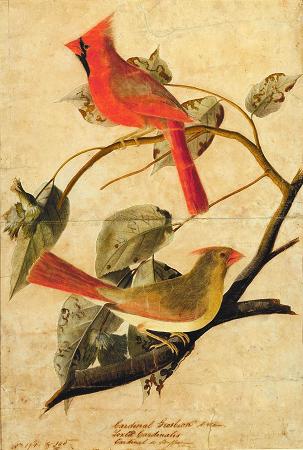Florida Cormorant (c1833). Etching, watercolor. 65 x 100. The double-crested cormorant is a member of the cormorant family of seabirds. Its habitat is near rivers and lakes as well as in coastal areas, and is widely distributed across North America, from the Aleutian Islands in Alaska down to Florida and Mexico. Measuring 70-90 cm in length, it is an all-black bird which gains a small double crest of black and white feathers in breeding season. It has a bare patch of orange-yellow facial skin. Five subspecies are recognized. It mainly eats fish and hunts by swimming and diving. Its feathers, like those of all cormorants, are not waterproof and it must spend time drying them out after spending time in the water. Once threatened by the use of DDT, the numbers of this bird have increased markedly in recent years. The double-crested cormorant was described by Rene Primevere Lesson in 1831. Its scientific name is derived from the Greek words, bald and, crow or raven, and the Latin auritus, eared, referring to its nuptial crests. Its common name refers to the same nuptial crests. Five subspecies are recognized: P. a. albociliatus, Farallon cormorant, breeds along the Pacific coast of North America from British Columbia to Bird Island in the state of Sinaloa, Mexico and possibly even further south. Significant colonies of these birds may also be found further inland including areas around the Salton Sea. According to currently available information, this subspecies is the third largest among the subspecies of the double-crested cormorant. Historical records indicate that this species was far more abundant in the past, but due to human persecution and development in their breeding range, the population of this subspecies has declined. The largest colony of cormorants in North America consisted of members of this subspecies at San Martin Island, Baja California Territory, Mexico, and was recorded in 1913. Physically, this subspecies is fairly large and has white to partially white nuptial crests. P. a. auritus, the nominate subspecies, has the largest and most widespread breeding population. It ranges from the Great Basin and Rocky Mountains east into central and eastern North America. This region includes the Canadian prairies and the Great Lakes. Historically, this subspecies has bred in abundance across most of this region, though there are questions as to whether this bird has always bred in the Great Lakes region. Some evidence indicates that the bird has only begun breeding in the region since the early 20th century while other evidence suggests that it has been breeding in the region much longer. Physically, this subspecies is moderately large and has black nuptial crests. P. a. cincinnatus, white-crested cormorant, currently this is the most geographically restricted subspecies with the smallest population. It is found along the southern coast of Alaska and on the Aleutian Islands, ranging west from Kodiak to Chuginidak in the Aleutians. Historically, the range extended west to the Near Islands, but possibly due to nest predation by introduced foxes, the birds were no longer breeding in the area by the mid-1930s. Physically, this subspecies is the largest and it bears straight, white nuptial crests. P. a. floridanus, Florida cormorant, the smallest of the five subspecies, it is found from southern and central Texas east to the Atlantic and from North Carolina south to Florida. Records indicate that this subspecies was abundant throughout its range before the 20th century, but now is only abundant in Florida. This bird has dark nuptial crests. P. a. heuretus This subspecies bears straight, white nuptial crests. Physically, it is the smallest. It has bare lores and a greenish gloss on the head and neck. It breeds only in the mangroves surrounding interior lakes of San Salvador in the Bahamas. It may also be resident on other Bahamian islands. The double-crested cormorant is a large waterbird with a stocky body, long neck, medium-sized tail, webbed feet, and a medium-sized hooked bill. It has a body length of between 70-90 cm long, with a wingspan of between 114-123 cm. Double-crested cormorants weigh between 1.2-2.5 kg. Males and females do not display sexual dimorphism. This species has dark-colored plumage with bare supra-loreal skin and gular skin that is yellow or orange. An adult in breeding plumage will be mostly black with the back and coverts being a dark grayish towards the center. Nuptial crests, for which the species is named, are either white, black or a mix of the two. These are located just above the eyes with the bare skin on the face of a breeding adult being orange. A non-breeding adult will lack the crests and have more yellowish skin around the face.
more...





